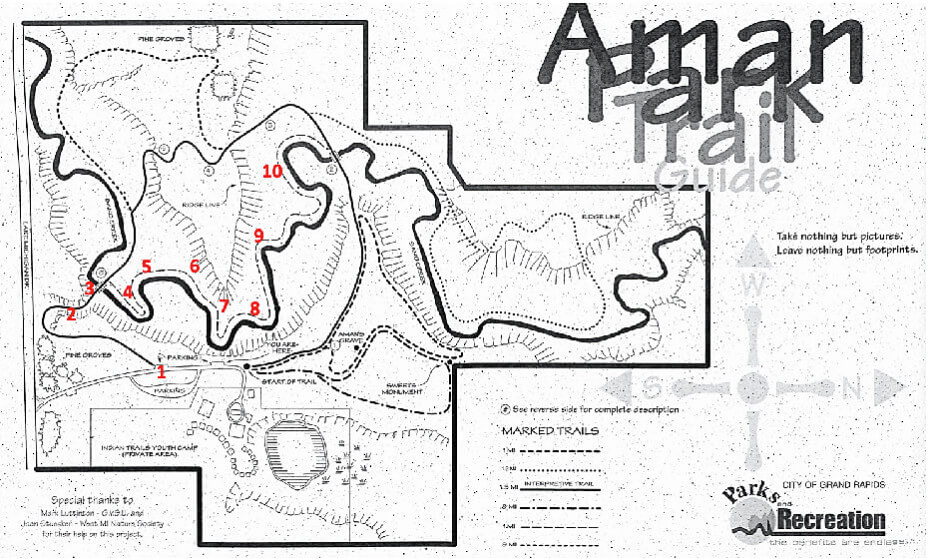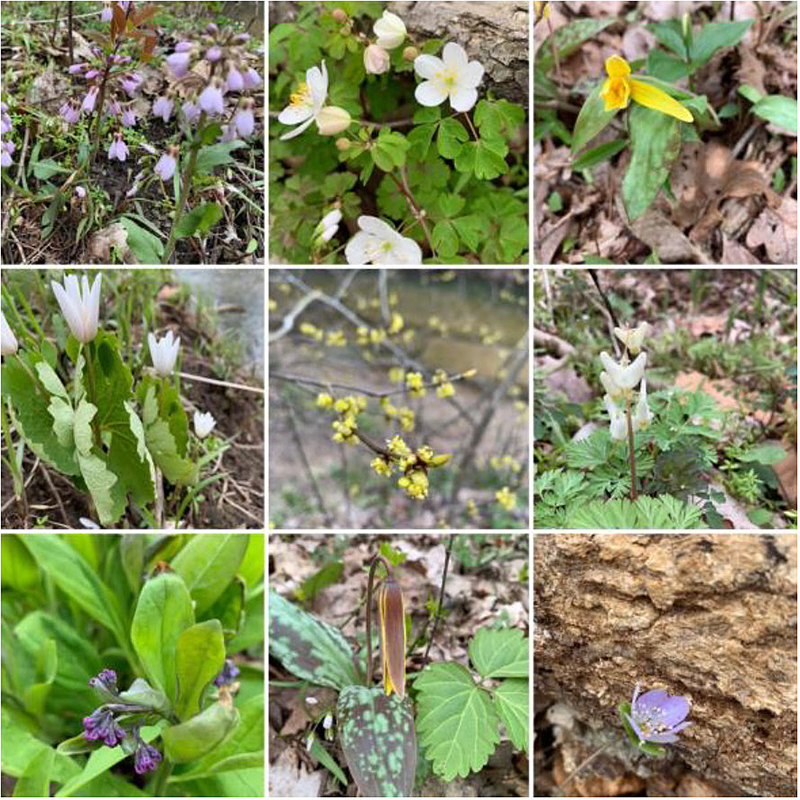
May 2020 Program: Plants & Ecology of Aman Park
Since this Spring is different for us, we wanted to find a new (and safe) way to learn about the unique ecosystems that are found at Aman Park. Members of the Program Committee and botanist Bill Martinus did a walking tour of a portion of Aman Park and here are their notes on the Ecology and Spring Wildflowers. Additionally, to supplement the cancelled guided hike and wildflower tour that was scheduled for May 18, 2020, we wanted to add historical context for Aman Park. Many thanks to Kayne Ferrier for doing this research and for writing this piece.
Enjoy learning about Aman Park through reading these notes and accompanying photos. We are hopeful that some of our members will be encouraged to head to the park on their own, using the information found in these pages to go on a self-guided tour. As all parks are experiencing an increase in visitation, Aman Park has traditionally been busy when the Trillium and Virginia Bluebells are in bloom. You may want to consider going in the morning or when it is raining, when fewer people will be there.
Aman Park’s address is 0-1859 Lake Michigan Dr NW, Grand Rapids 49534
If a visit to Aman Park is not possible, we are delighted to direct you to a video series, created by Craig Elston, of CDE Nature and the Hudsonville Nature Center. Craig also furnished the photographs of some of the plants that can be found in Aman Park. Craig Elston’s Video Series on Spring Wildflowers
Please consider going outside to find examples of the various spring wildflowers in your own garden, neighborhood or at local parks. Share photos by emailing them to Ruth Oldenburg, Communication Chair of Wild Ones River City (WORC) at [email protected]. If you would like to include a note with a few details, Ruth will add them to a future addition of the WORC e-news.
May the sharing and/or finding of these different Spring wildflowers, bring you inspiration, encouragement, and joy during these uncertain times.
Click on the link below (or on the photo collage)
to view/download the photo presentation.
AMAN PARK IMAGES PRESENTATION PDF
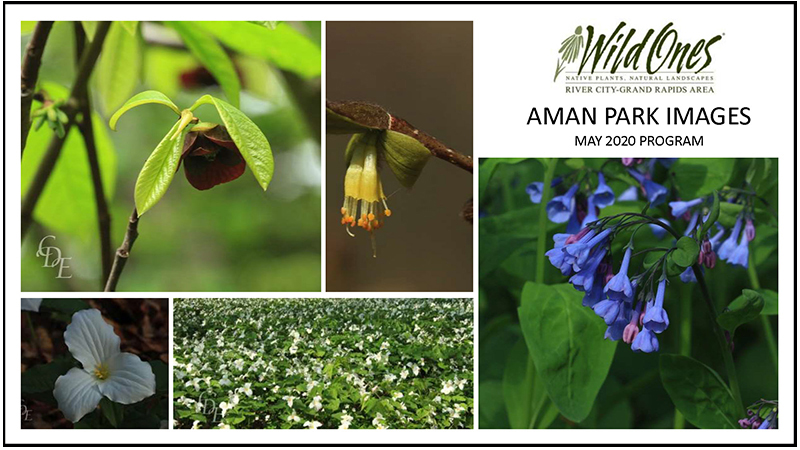
William Martinus’ Guided Tour for Wild Ones River City Chapter
Understanding the Plant Communities & Natural History and Useful Tools
A basic simplified geology of the Aman Park area: Glaciers left the assorted sands, clays, and gravels of the rolling hills of the area about 18,000 years ago. The “flats” west of the Grand River continuing through Allendale, are from a former Grand River delta. West of Allendale to Lake Michigan are a series of former higher, post-glacial lake beds. As they dried up, low dunes formed, sweeping across the dried sands. A vast remnant marsh was centered around 120th Ave. x M-45, and was drained in the early 1900s.
- Original survey maps from early 1830 are available at Loutit Library
- Aerial photos of Ottawa County taken in the 1930s can show a snapshot of history
- Atlas of pre-settlement vegetation shows that three forest types existed in Aman Park:
1. Beech-Maple Forest west of Sand Creek
2. Mixed Hardwood Forest east of Sand Creek
3. Mixed Conifer Swamp surrounding the small lake (off limits to the public)
Comer, P.J., D.A. Albert, H.A. Wells, B.L. Hart, J.B. Raab, D.L. Price, D.M. Kashian, R.A. Corner, and D.W. Schuen. 1995. Michigan’s pre-settlement vegetation, as interpreted from the General Land Office Surveys 1816-1856. Michigan Natural Features Inventory, Lansing, MI.
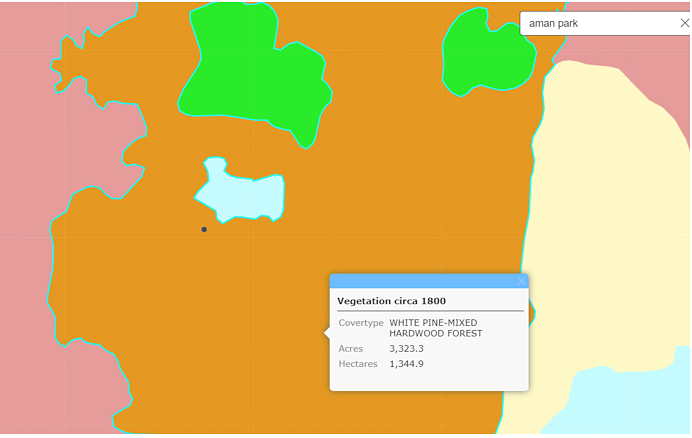
https://mnfi.anr.msu.edu/resources/vegetation-circa-1800
- Plant communities of Michigan
Kost, M.A., D.A. Albert, J.G. Cohen, B.S. Slaughter, R.K. Schillo, C.R. Weber, and K.A. Chapman. 2007. Natural Communities of Michigan: Classification and Description. Michigan Natural Features Inventory, Report Number 2007-21, Lansing, MI. 314 pp. - Plant species of Michigan
MICHIGAN FLORA ONLINE. A. A. Reznicek, E. G. Voss, & B. S. Walters. February 2011. University of Michigan. Web. https://michiganflora.net/ - Tools that can be valuable in the field:
• GARMIN Eltrex 10 – can track where you walk, as seen in the locations we used for STOPPING POINTS, but also allows you to “click” a location to get the coordinates for reference. For example, the identification of a Viburnum was not immediately known during the hike, we captured the coordinates so that it would be easy to revisit. At Stopping Point #10 you will find that the identification was later determined.
• Binoculars are useful in checking out plants, birds and butterflies: 8×10 power; close range. Look through them backwards to use them as a magnifying lens
Click the link below to view/download William Martinus’ Guided Tour of Aman Park pdf.
William Martinus has compiled an extensive Natural Features Inventory of Aman Park.
Click the link below to view/download.
NATURAL FEATURES INVENTORY OF AMAN PARK
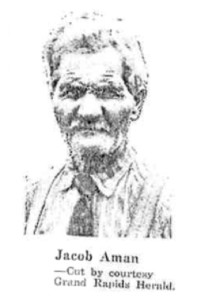
History of Aman Park: A Gift from Jacob Aman
By Kayne Ferrier for Wild Ones River City Chapter
In 1900 Jacob Aman purchased the property that today is named in his honor for $5,050. Even though he had donated the property to the City in 1926, he retained “life estate” use of 10 acres that he could timber and cultivate as a modest farm for himself.
Based on this agreement, Jacob became supervisor of the park and as such, he established walkways and picnic areas and other areas that pleased him. He thought about the possibility that the City might establish an orphanage there to give kids, who like him, were left alone in the world.
At one time in the 20th century, the City considered opening a School of Forestry there. It has been primarily used as a natural park and has served as an educational resource for several decades to higher education institutions like Calvin University and Grand Valley State University.
Jacob Aman was born on April 9, 1849 in Starr County, Ohio. His parents were immigrants from Alsace-Lorraine, a German-influenced territory in France. Aman reported that his father died when he was 13 and he was put out to fend for himself. He considered himself a “half-orphan.”
He married Sarah Gaul on September 25, 1872, came to Grand Rapids in 1875, and by the time of the 1880 US Census, they had 4 children: George, 7 yrs, Minnie 5 yrs, Nellie 3 yrs, and “Inie I” (Ina Irene) 9 ½ months.
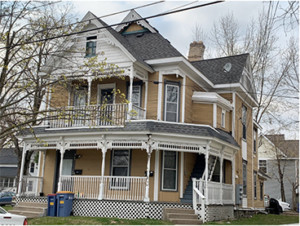
Aman earned his living as a carpenter. He is credited with building many homes on the city’s West Side. Some call this house “The Wedding Cake House”, it still exists at the NE corner of Dayton and Indiana SW.
In 1880 he and Sarah lived at 18 Dayton SW; a location that no longer exists nor does a subsequent address at Tolbert and Earle. In 1882 they moved to Park St. SW.
Aman divorced in 1890 and by 1900 purchased a large parcel of land that included rich forests and floodplains along Sand Creek in the eastern edge of Ottawa County, on Lake Michigan Drive.


The park initially was 254 acres in size. Two of Aman’s neighbors added to the park by donating property. In 1924 Dr. Joel C. Parker donated 22 acres and William F. Sweet donated 40 acres. Both Mr. Aman and Mr. Sweet are buried in Aman Park. Here we see the plaque and boulder marking the site for Mr. Sweet.
By 1926, as an aged man, Mr. Aman chose to donate the 254 acres of woods and farmland that had been his home for 26 years to the City of Grand Rapids. He saw that Grand Rapids was growing and believed it would need a park at its western border.
A gift of real estate of this size, especially while the country was still in the grips of the Great Depression, made news across the state.
Jacob Aman lived the rest of his life among the birds and other wildlife, eventually sleeping on a cot in a what can only be described as a shack. He contracted pneumonia in July 1928 and died in Blodgett Hospital on July 11, 1928.


Jacob chose to be buried in his park at a site he had pre-selected. He wanted to remain among the birds, flowers and trees—Nature—that he loved so much and that brought him peace.
For five years in the 1930s the City had grade school and high school children plant oak seedlings and walnuts in a dedicated 50 acre tract in an attempt to reforest the park. Additionally, the City used this greenspace as a tree nursery.

The City of Grand Rapids permanently granted 15 acres of Aman Park, including Root Beer Lake (formerly known as Lake Jacobina) to the Indian Trails Camp in 1953. Initially the Rotary sponsored a camp on the site for children with disabilities.
The Wild Ones River City Program Committee wanted to add historical context for Aman Park to supplement the cancelled guided hike and wildflower tour that was scheduled for May 18, 2020. Many thanks to Kayne Ferrier for doing this research and for writing this piece.
KAYNE L. FERRIER, MLS is a retired public librarian. She worked for the Grand Rapids Public Library for 23 years. Following a brief retirement period, she was hired by the City of Grand Rapids Water Resource Recovery Facility to organize their library and write its history.
SOURCES:
Various readings found on Newspapers.com; the Aman vertical file in the Grand Rapids Public Library’s Local History Department that included old Grand Rapids Herald and Grand Rapids Press articles about Jacob Aman and his donation of the park property to the City; The Story of Grand Rapids by ZZ Lydens; Keep on the Grass: A Brief History of Grand Rapids Parks by the Grand Rapids Historical Commission.
IMAGES:
- Contemporary sign at entrance of Aman Park, Wedding Cake House, William Sweet plaque and boulder, and Lake Jocobina – Kayne Ferrier
- Trillium on page 1, Craig Elston of CDE Nature
- Black and white photo of plaque on boulder for Jacob Aman, Joan Meyer
- Rolling hills of Trillium with log in foreground, Google images.

